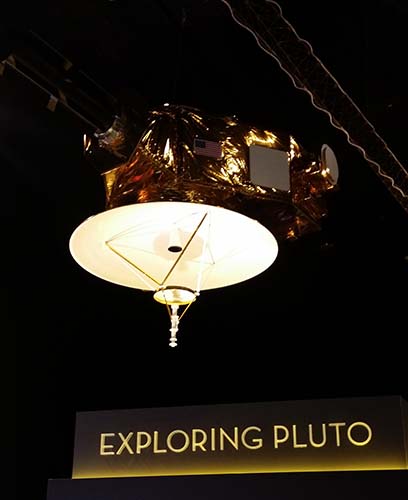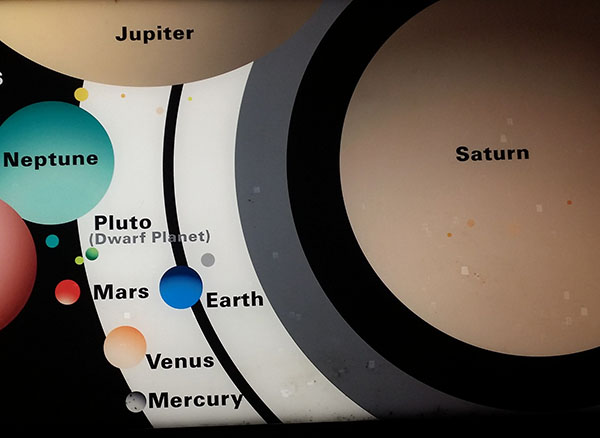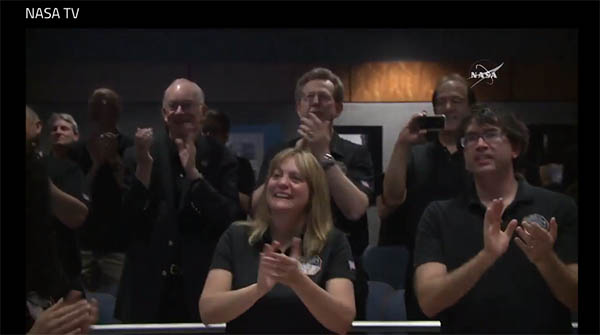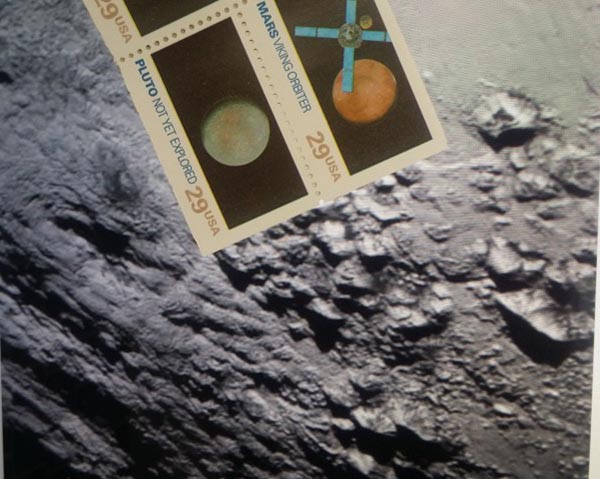“Yay! Pluto will always be part of our hearts,” a 17-year old exclaims to her companion.
“Pluto just needs a good PR rep,” a dad jokes to his son after reading the formal definition of planet and figuring out why Pluto isn’t one.
“Pluto’s a dog.” “I know it’s a dog. It’s also a dwarf planet,” two friends banter back and forth.
These were a few quotes I overheard while eavesdropping at the Smithsonian Air and Space Museum a few weeks ago. Pluto, though demoted from a planet to a dwarf planet in 2006 for failing to “clear the neighborhood of its orbit,” remains part of the “Exploring the Planets” exhibit. A scale model of New Horizons—the probe that made its closest approach to the icy underdog on July 14, 2015—hangs above a kiosk that in bright yellow letters reads “Exploring Pluto.” A screen shows the latest images and encourages users to visit the New Horizon’s website with even more information. One teenager passes by and explains to his mom, with confusion, that New Horizons has reached Pluto (though at the time it was still a few weeks away). The mom sighs, “poor Pluto.”

Image: Model of New Horizons spacecraft at Smithsonian Air and Space Museum. Photo by author.
Today, a week after New Horizon’s closest approach, can we say we have now explored Pluto? What does it mean to explore a body so distant, incomprehensibly beyond and incapable of human being? And, importantly, who’s the “we” lauding humanity’s new found Plutonian knowledge and what does that mean for politics of contemporary exploration?
New Horizons launched on January 19, 2006. The fastest craft ever to leave earth, its main target was Pluto, the ninth planet and the only one yet to be the target of an interplanetary craft. In August of the same year, astronomers assembled at the International Astronomical Union voted on a definition of planet that excluded Pluto. New Horizons became, then, not the mission to the last planet but the first mission to Pluto and its fellow Kuiper Belt Objects (the hundreds of small icy bodies orbiting beyond Neptune).

Image: Clear messaging of the “dwarf planet” status of Pluto at the Air and Space Museum. Photo by author.
I started graduate school a few weeks after this resounding demotion, made relevant to me by my roommate who at the time was working toward a Ph.D. in planetary science focusing on the study of Kuiper Belt Objects.
During my first year in graduate school, I wrote a term paper attempting an STS analysis of Pluto’s demotion. My instructor at the time was, I suspect, disappointed that for a class focusing on power and political aspects of technoscience I was writing about an ice ball many millions of miles away. Yet Pluto started me thinking about how planets are both scientific and cultural objects and that there are indeed subtle political stakes that stem from this configuration [1].
These stakes swirl around the idea of “exploration.” When will we have explored Pluto? Did it happen during New Horizon’s closest approach? When the scientists downloaded the highest resolution image of Pluto’s entire surface? In the coming year, as scientists sift through the data and characterize the atmosphere and geologic features?

Image: Screenshot from NASA TV. Mission control applauding high resolution image of Pluto.
One moment of achievement in exploration came Monday night, July 13th, on the eve of New Horizon’s closest approach. That is when the satellite transmitted the high-resolution portrait of Pluto that space fans woke up to on Tuesday morning. Those assembled in mission control at the Johns Hopkins University Applied Physics Laboratory stood up and cheered, similar to iconic images taken after Apollo splash downs.
The next morning, an even more crowded control room awaited New Horizon’s closest approach. Though the satellite was taking data and therefore not transmitting to mission control, hundreds of people cheered on a countdown and watched a virtual simulation of New Horizons zooming past Pluto. Mission control was cheering for an encounter no human was experiencing, even remotely. Yet, this did not keep the MC covering the event for NASA TV from declaring “America’s space program has written a new chapter in science and exploration.” Exploration happened, but humans weren’t directly involved.
But who is the “we” doing the exploring? One headline from BusinessInsider.com read “Humanity just visited Pluto for the 1st time.” In the very same article, there is a GIF of the mostly white, mostly male audience waving American flags to celebrate Pluto’s approach (same rhetoric and juxtaposition here). Likewise, the press conference that convened promptly after the closest approach concluded with the three panelists waving American flags (presumably left over from the earlier celebration).
There is nothing surprising in these politics of space exploration. NASA’s mission has always been nationalistic [2]. But, if exploration is no longer a demonstration of democracy’s success over communism’s failure what foe is NASA up against? The answer might be itself or at least its own government. As NASA’s budget, especially for the planetary sciences, shrinks and stagnates, tying American values to exploration ensures NASA’s relevance. Reported by the Washington Post right after New Horizon’s closest approach: “‘We are a country of explorers,’ said John Grunsfeld, NASA’s top official for science, just before the New Horizons team initiated a countdown marking the spacecraft’s closest approach to the dwarf planet. ‘I’m extremely proud to be part of the country that first explored the whole solar system.’”

Academic musings aside, this is pretty damn cool. Image: “Pluto: Not Yet Explored” stamp from 1992 held up alongside an image returned from New Horizons of the surface of Pluto. Photo by author and NASA/JHU APL/SwRI.
Explored. Finished. Done. But of course this is only the beginning of coming to know the kind of world Pluto is. Mission scientists have likened the coming year to be like opening a birthday present each day as they analyze the data the New Horizons slowly sends back to its motherland. To maintain interest and, importantly, funding, perhaps best to follow the lead of the Air and Space museum and discuss how we are “Exploring Pluto.”
Footnotes
[1] Messeri, Lisa. 2010. “The Problem with Pluto: Conflicting Cosmologies and the Classification of Planets.” Social Studies of Science 40(2): 187-214.
[2] McDougall, Walter. 1985. The Heavens and the Earth: A Political History of the Space Age. Baltimore: Johns Hopkins University Press.

2 Comments
Thank you for the insightful and timely post. I’m reminded of Carl Sagan’s words in Pale Blue Dot as he is discussing the 1976 robotic Viking missions and writes: “[…] in a certain sense I spent a year on Mars. I examined the boulders and sand dunes, the red sky even at high noon, the ancient river valleys, the soaring volcanic mountains, the fierce wind erosion, the laminated polar terrain, the two dark potato-shaped moons.”
The poetry of telexploration is fascinating, and I’ve been thinking about this in terms of interstellar travel myself. When NASA says Voyager has been to interstellar space, does that mean ‘we’ have? Is the human interstellar voyage already underway in this “certain sense,” as Sagan calls it? From the poetry of scientific descriptions for the popular imagination to the wonder of sci-fi, we seem to spend a good amount of time there already.
I also wonder how technology like the HoloLens (en route to ISS now, and prepped for use with Mars rovers) might direct even more effort toward remote exploration by making it feel continuously less remote. Whether through VR, PR, or poetry, these sites in space so often appear to feel intimate to those engaged with them. I know they have that effect on me!
Great comments, Michael. The history (and future) of 20th-21st century space exploration can absolutely be written as a trend towards ever increasing sense of presence. Sagan’s poetics come in part from his viewing of 3D landscapes returned from the Viking landers. NASA continues to invest in developing more seamless 3D experiences (HoloLens being the latest). The great ethnographic question here is whether remote presence can every be “the same” (however you wish to define it) as physical presence.
I’m sure the folks at the core of New Horizons feel like they too have spent the past week on Pluto. But they are of course on Earth. Does that distinction matter?
1 Trackback